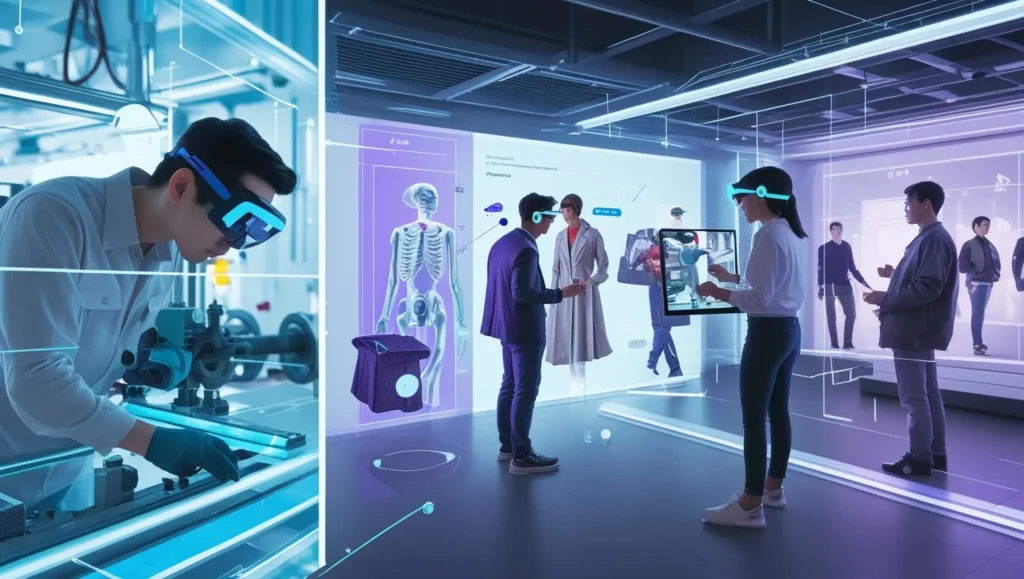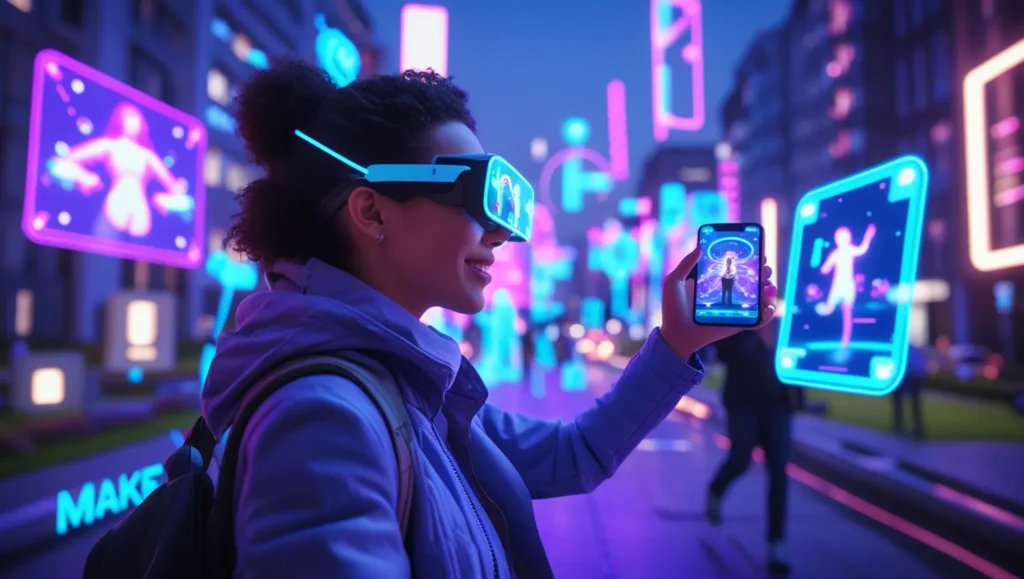
What is Augmented Reality?
Augmented Reality (AR) is a cutting-edge technology that overlays digital content such as images, sounds, text, or 3D objects onto the real world, creating an interactive experience where virtual elements blend seamlessly with physical surroundings. Unlike Virtual Reality (VR), which replaces the real world, AR enhances it by adding smart digital layers to what you see and experience every day.
Augmented Reality is transforming how we interact with the world. We will learn all about it and how it works in 2025. Imagine pointing your phone’s camera at an empty wall and seeing a fully furnished room with couches, lamps, and paintings all overlaid on your screen in real time. That’s Augmented Reality the integration of interactive digital elements into our physical world enhancing how we live work play, and connect.
In simple terms AR doesn’t replace the real world it enhances it by layering computer-generated visuals sounds and information onto it. AR is already a part of our lives from Snapchat filters and Instagram face masks to surgical navigation systems and interactive shopping apps. We’re only scratching the surface of this world.
Evolution of Augmented Reality
A Historical Timeline
Here is the Complete history of Augmented Reality
1960s–1980s: The Foundations of AR
1968: Ivan Sutherland creates the first-ever head-mounted display (HMD), known as the “Sword of Damocles.” It was a groundbreaking step, where a computer rendered graphics in real-time.
1975: Myron Krueger introduces “Videoplace”, an interactive environment allowing users to engage with virtual objects using their body movements.
1980: Gavan Lintern from the University of Illinois publishes a pioneering study showing how heads-up displays (HUDs) enhance real-world flight training.
1980: Steve Mann builds the first wearable computer, which overlays text and graphics onto a live photographic scene an early step toward wearable AR.
1986: Within IBM, Ron Feigenblatt conceptualizes what we now call the “magic window” experience, holding a smart display (like a smartphone) to view AR overlays.
1987: Douglas George and Robert Morris develop a telescope-based heads-up display system that overlays celestial data on the real night sky a precursor to modern AR.
1990s: The Term ‘Augmented Reality’ is Born
1990: Thomas P. Caudell, a Boeing researcher, coined the term Augmented Reality while working on AR-guided assembly systems.
1992: Louis Rosenberg develops “Virtual Fixtures” at the U.S. Air Force Research Lab, one of the first operational AR systems that enhanced user perception.
1992: Researchers Steven Feiner, Blair MacIntyre, and Doree Seligmann present “KARMA,” an early AR prototype at the Graphics Interface conference.
1993: Mike Abernathy and team use AR for space debris tracking, overlaying satellite trajectories onto live telescope footage.
1993: The Communications of the ACM publishes a landmark issue on computer-augmented environments, bringing AR into academic focus.
1993: Loral WDL conducts a live AR simulation combining real vehicles and manned simulators, an early example of AR in military training.
1995: S. Ravela and his team introduced a monocular vision-based system to track objects across views a breakthrough for object recognition in AR.
1996: General Electric develops an AR system to project data from 3D CAD models onto real-world counterparts.
1998: The concept of Spatial Augmented Reality (SAR) is introduced by Ramesh Raskar and colleagues at UNC Chapel Hill, projecting visuals directly onto physical surfaces.
1999: AR sees military adoption as Frank Delgado and Mike Abernathy successfully test LandForm video overlays during helicopter flight.
1999: The US Navy begins a decade-long research project titled Battlefield Augmented Reality System (BARS) to aid soldiers with wearable AR tech in urban warfare.
1999: NASA tests LandForm AR overlays in the X-38 spaceflight project, visualizing terrains beneath cloud cover.
2000s: Going Wireless and Mainstream
2000: Rockwell demonstrates a wireless, tetherless AR system for outdoor environments supporting video, 3D audio, and terrain data overlays in real time.
2004: Trimble Navigation and the HIT Lab unveil an outdoor helmet-mounted AR system.
2006: Outland Research creates an AR media player that synchronizes music with real-world visual overlays, offering immersive entertainment.
2008: Wikitude launches the first AR travel guide app for Android, leveraging GPS and camera views for location-based information.
2009: FLARToolkit brings AR to web browsers via Adobe Flash, opening new doors for developers and marketers alike.
2010s: AR Hits the Consumer Market
2012: Lyteshot introduces an AR-based interactive gaming system using smart glasses.
2013: Niantic releases Ingress, a location-based AR mobile game, setting the stage for Pokémon Go.
2015: Microsoft unveils the HoloLens, a groundbreaking AR headset blending sensors, processors, and holographic projections.
2016: Pokémon Go launches and becomes a global phenomenon, pushing Augmented Reality into the public spotlight.
2018: Magic Leap releases the Magic Leap One headset. Leap Motion follows with the open-source Project North Star AR headset.
2019: Microsoft HoloLens 2 is introduced, offering improved field of view and better ergonomics for industrial and enterprise use.
2020s: The AR Race Accelerates
2022: Magic Leap 2 enters the market with refined hardware aimed at professional and medical applications.
2023: Meta launches the Quest 3, a mixed reality headset. Apple debuts the highly anticipated Vision Pro, blurring the lines between AR and VR.
2024: Meta Platforms reveals the Orion AR Glasses prototype an effort to make AR wearables more compact and user-friendly.
2025: Augmented Reality Becomes Everyday Tech
2025: Augmented Reality continues to integrate into daily life, with AR glasses becoming lighter, more affordable, and compatible with mainstream apps. Major tech firms like Apple, Meta, Google, and Samsung are competing to dominate the consumer AR market.
New AR-enabled smartphones, smart contact lens prototypes, and AI-driven real-time translation overlays are making headlines. In education, AR-powered classrooms are being piloted across Europe and Asia, while retail giants expand immersive shopping experiences using AR mirrors and product previews. 2025 marks a pivotal shift AR is no longer futuristic; it’s functional, personal, and widely adopted.
How Augmented Reality Works
Ever wonder how your phone knows where to place a virtual dinosaur in your living room?
Here’s how AR systems function:
A. Sensors and Cameras
They collect real-world data on depth, light, angles, and help AR systems understand the environment. This includes LIDAR, GPS, gyroscopes, accelerometers, and standard smartphone cameras.
B. Processing
The collected data is processed in real-time by the AR engine, whether in a smartphone, tablet, AR glasses, or headset.
C. Projection and Rendering
Once the environment is understood, the AR engine renders digital elements (e.g., 3D models, images, sound) and overlays them accurately onto the user’s view, adjusting as they move.
D. Interaction
Users can interact with virtual elements using gestures, voice, gaze tracking, or touch, depending on the device.
Types of Augmented Reality
There are four major types of AR Technology
Marker-Based AR Image Recognition
Uses a visual marker (like a QR code or symbol) to trigger content. When the camera detects the marker, it overlays a specific 3D object.
Example: Museum exhibits that come alive when scanned.
Marker less AR Location-Based
This is GPS or sensor-based, allowing AR to work without a specific image target.
Example: Pokémon GO placing creatures at different real-world locations.
Projection-Based AR
Uses projectors to beam light onto surfaces and create interactive holograms no screen needed.
Example: Holographic keyboards or 3D product projections in showrooms.
SLAM-Based AR (Simultaneous Localization and Mapping)
This is the most advanced. It scans the environment in real-time and creates 3D maps to place virtual objects.
Example: Apple’s ARKit and IKEA Place app that lets you preview furniture in your room.
Applications of Augmented Reality in the Real World

Lets explore industry by industry how AR is creating value.
Retail & E-Commerce
- Virtual Try-On: See how shoes, glasses, or clothes look on you using apps like Nike Fit or Warby Parker.
- Product Placement: Visualize furniture or electronics in your home before buying.
Stats: 71% of shoppers say they would shop more often if AR were available.
Education & Training
- Immersive learning: Medical students can dissect virtual cadavers.
- Historical reconstructions: Walk through ancient cities overlaid on modern ones.
Example: Google Expeditions lets students take AR field trips in class.
Healthcare
- Surgical Assistance: Overlaying digital information on a surgeon’s view during operations.
- Medical Training: Simulate patient conditions for practice without risk.
Gaming & Entertainment
Pokémon GO, AR escape rooms, AR-enabled toys, and immersive museum tours
Manufacturing & Maintenance
Workers use AR glasses to view complex schematics, manuals, or repair steps hands-free.
Real Estate & Architecture
- Potential buyers take AR tours of unfinished buildings.
- Architects preview designs at scale on actual sites.
Key Technologies Powering AR
To make AR happen, multiple technologies work together:
Technology Role
AR SDKs (ARKit, AR Core) provide tools for developers to build AR apps
LIDAR & Depth Sensors help devices understand distance and depth
5G & Edge Computing Deliver high-speed, real-time rendering
AI & ML improve object recognition, tracking, and user interaction
Wearables (Smart Glasses) make hands-free AR possible
Advantages of Augmented Reality
✅ Enhanced User Experience
AR adds a new layer of engagement and interactivity.
✅ Improved Learning & Productivity
By visualizing information, users retain more knowledge and make decisions faster.
✅ Increased Conversion in Retail
Brands using AR have reported up to a 200% increase in conversion rates.
✅ Accessibility
Now available on most smartphones no need for fancy headsets.
Challenges and Limitations
Privacy Concerns
AR apps collect sensitive location and environmental data.
High Development Costs
Creating high-quality AR experiences isn’t cheap.
Hardware Limitations
Battery life, camera quality, and display limitations restrict advanced AR use on mobile.
Digital Overload
Constant overlays may become overwhelming and distract users.
Future of Augmented Reality
We’re heading toward a world where AR will be as common as the internet. Key future trends include:
- AR Glasses for Everyday Use: Apple Vision Pro, Meta Quest 3, Google Glass 2.0
- AR in Web Browsers: No app needed for this. Augmented Reality will run directly in browsers (Web AR).
- The AR Cloud: A shared digital layer over the physical world.
- AI-Powered AR: Dynamic experiences that learn from user behavior.
Prediction: According to Statista, the global AR market is projected to surpass $198 billion by 2025.
Read More: Advanced Technology Blogs
Frequently Asked Questions
What is Augmented Reality?
Augmented Reality (AR) is a technology that overlays digital elements such as text, images, sounds, or 3D models onto the real world, creating an interactive blend of virtual and physical experiences.
How is Augmented Reality different from Virtual Reality?
AR (Augmented Reality) adds digital objects to the real world, while VR (Virtual Reality) creates a completely virtual environment that replaces the real world.
How does Augmented Reality work?
Augmented Reality works by using a device’s camera and sensors to detect the real environment, then overlaying digital objects, sounds, or animations in real time.
What is an example of Augmented Reality?
A common example of Augmented Reality is Pokémon Go, a mobile game where virtual characters appear in real-world locations through your phone’s camera.
What is the main purpose of Augmented Reality?
The main purpose of Augmented Reality is to enhance real-world environments with digital information, making learning, shopping, gaming, and entertainment more engaging and interactive.
Can I use AR on any smartphone?
Most newer phones (2018 onward) support AR through ARKit (iOS) or AR Core (Android). Older devices may lack sensor accuracy.
Is Augmented Reality safe to use?
Yes, but overuse may lead to eye strain. Also, be mindful of privacy when using location-based AR apps
What are the best AR apps in 2025?
Top apps include IKEA Place, Google Lens, Snapchat AR, Pokémon GO, and Shopify’s AR Viewer.
How can businesses benefit from AR?
From product visualization and customer education to training and marketing, AR enhances engagement and conversions across industries
Conclusion
Augmented Reality is one of those rare technologies that blends utility with wonder. It has the power to transform education, medicine, shopping, entertainment, and work not by replacing reality, but by enriching it.
For tech enthusiasts, developers, entrepreneurs, and curious minds alike, AR isn’t a trend it’s a shift in how we perceive and interact with the digital world. So, whether you’re building the next AR startup or just exploring filters on Instagram, know that you ‘re part of a much bigger revolution one where reality becomes interactive.


